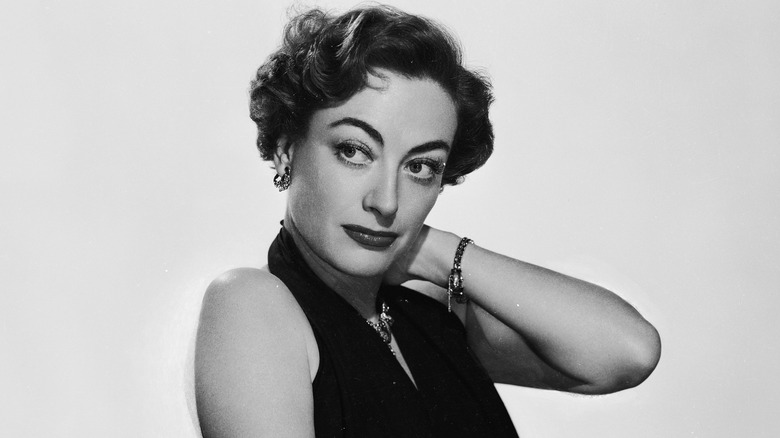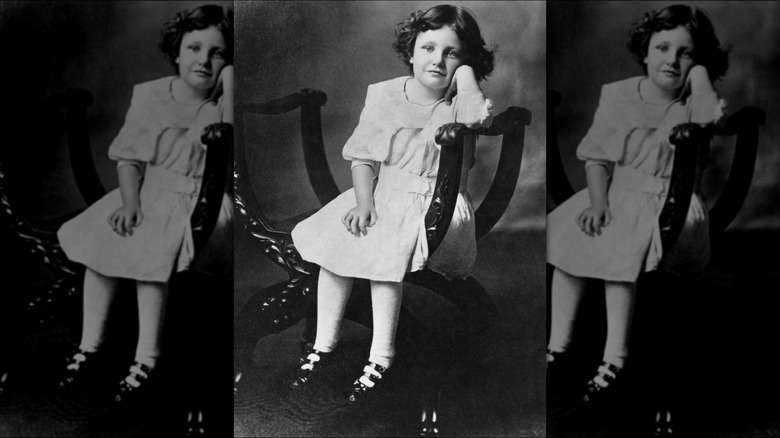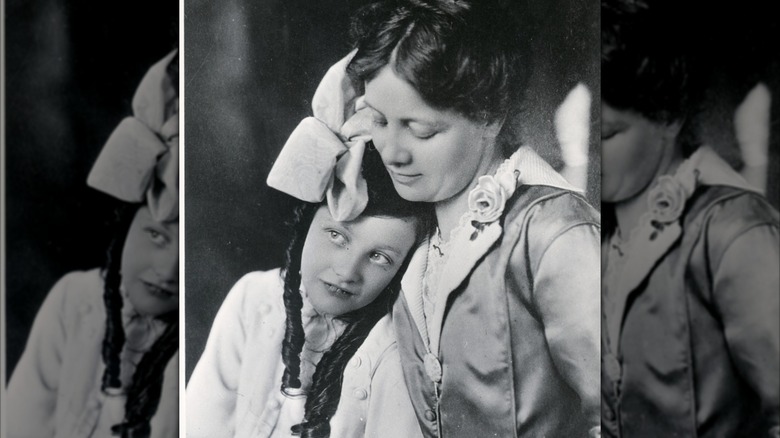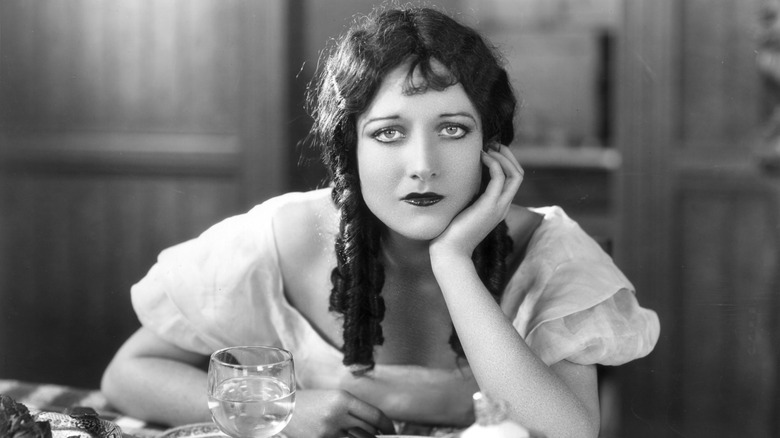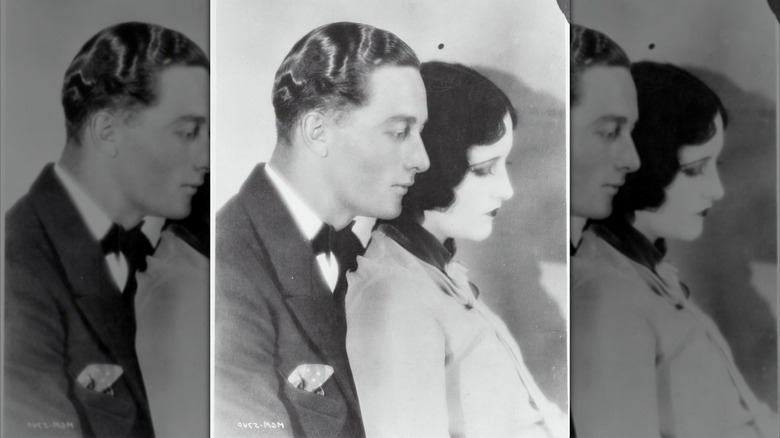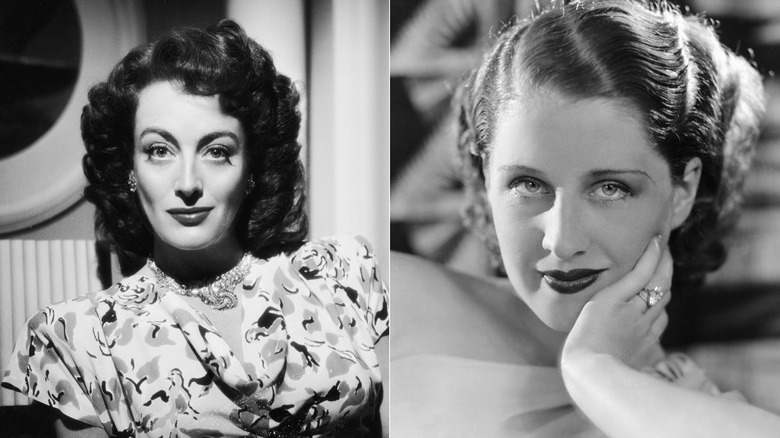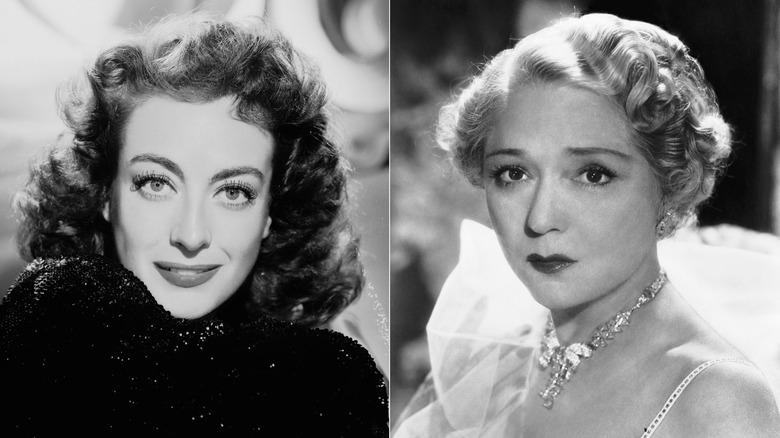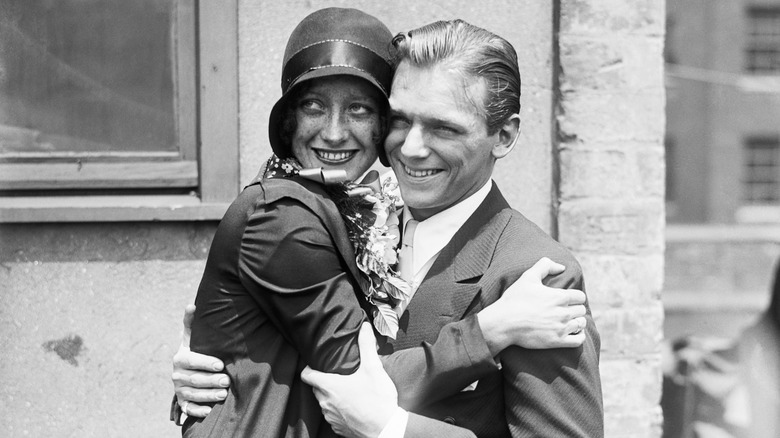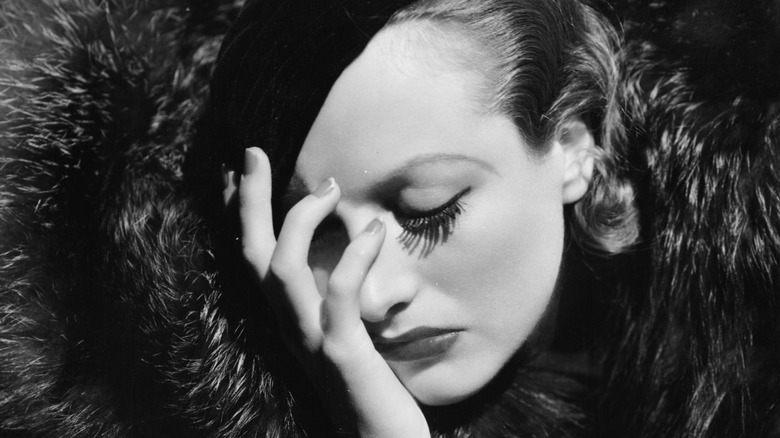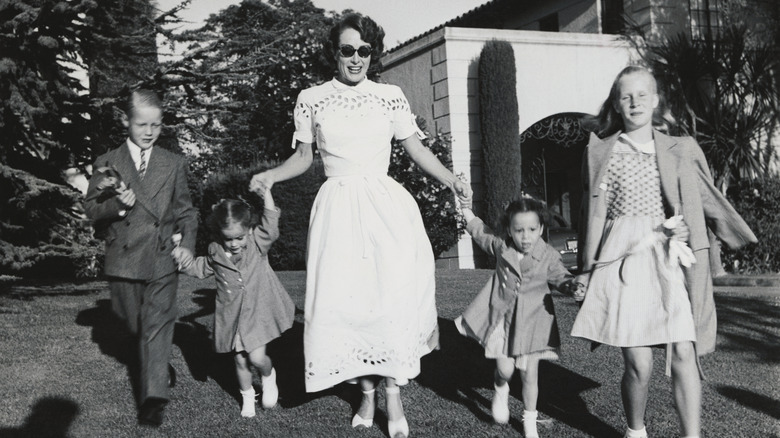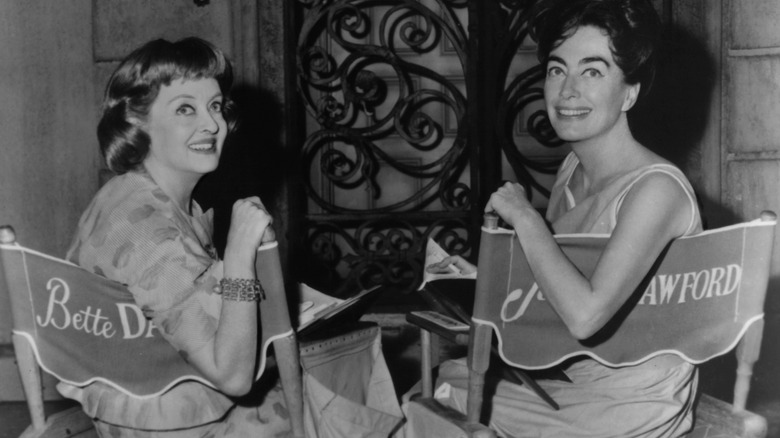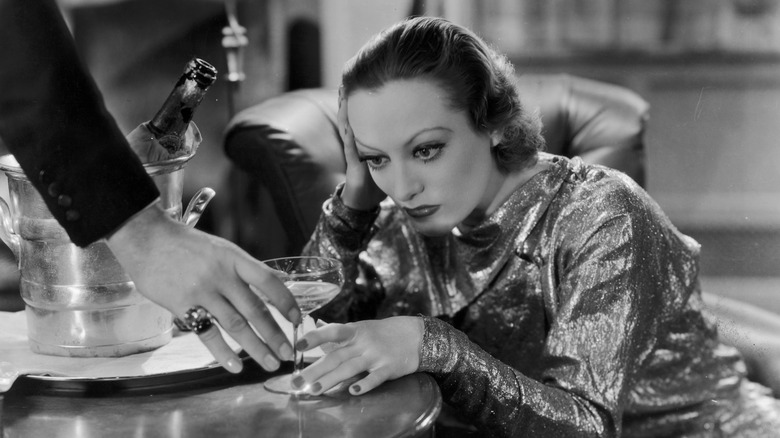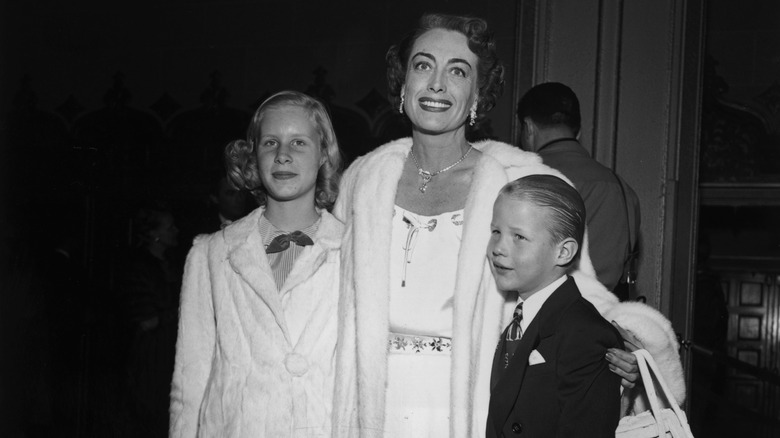Tragic Details About Joan Crawford's Life
This article contains mentions of child abuse and sexual assault.
From her Oscar-winning turn in "Mildred Pierce" to her scandalous personal life, Joan Crawford was a decades-long fixture in Hollywood. She got her start as a chorus girl, before the minds at Metro-Goldwyn-Mayer plucked her out of obscurity in 1924. Somehow, the brunette beauty was able to withstand the sea of change from silent films to "talkies" and skyrocket to fame in the early 1930s with her dramatic films.
The former dancer was known for playing beautiful, complicated, and strong-willed women. She was an icon during the Great Depression, and her flicks enticed audiences by depicting a world where ambitious women could pull themselves up by their bootstraps. She achieved the kind of success most only see on movie screens, but behind the glitz, the glam, the private pools, and the shockingly high Hollywood paychecks, Crawford's life was marked by a series of tragic events.
From a hardscrabble childhood as a self-described "workhorse" to a string of high-profile and heartbreaking marriages and divorces to her estrangement from her two eldest children later in life, Joan Crawford's rags-to-riches story shows that money and fame do not always shield us from life's darker turns. In remembering Crawford's legacy, let's dig deep into the archives and turn over some of the more tragic skeletons in the star's couture-filled closet.
Joan Crawford's biological father abandoned the family
Although some of the most well-known images of Joan Crawford show her in glittering gowns and her trademark shoulder pads, her childhood was anything but flashy. In fact, her life was marked by tragedy early on. She was born in the city of San Antonio, Texas, on March 23, 1904. Her parents, Anna Bell Johnson LeSueur and Thomas LeSueur, named their little Aries baby Lucille Fay LeSueur. However, the name wouldn't stick; her childhood nickname became "Billie."
Little Billie was the third of her parents' children. A prior daughter, Daisy, had passed away in infancy, and a boy, Hal, had been born just a year earlier in 1903. Life had its struggles, but real financial strife didn't hit until Mr. LeSueur abandoned the family not long after his second daughter was born. LeSueur, a French-Canadian migrant in America, was accustomed to moving around. And one day, after leaving home for a contracting job, the father of two simply never returned.
Not only did this condemn Crawford (as she would later be known) to never knowing her biological father, but it also catapulted her and her family into the economic underclass. The biographers behind "Joan Crawford – The Essential Biography" claimed that Crawford's mother was "bitter" over the abandonment and struggled to provide a stable life for her children. The trio lived in impoverished quarters and were eventually forced to move out of their hometown of San Antonio in search of greener pastures.
Joan Crawford's stepfather abused her
After her husband abandoned the family, Anna Bell Johnson LeSueur moved she and her two children to Lawton, Oklahoma. There, the savvy mother was able to seduce a local business owner named Harry Cassin, and the two were soon married. Cassin was the owner of an opera house. He had a steady income, and his marriage to Crawford's mother meant that the family's days of financial struggle were over.
With a front-row seat to the backstage goings-ons at the opera house, Crawford began to fall in love with the entertainment industry. However, the relationship between her and Cassin would soon turn dark. It wasn't until she was much older that Crawford revealed she had been sexually assaulted by her stepfather. Yet even as an adult, Crawford was unable to view her stepfather's actions as villainous. "He was gentle," she later said, "and I led him into it." In Crawford's memory, she cast herself as the instigator of a love affair, not the victim of an act of abuse.
When Crawford's mother discovered that her husband had been abusing her daughter, she filed for divorce and separated her children from her ex. However, Anna LeSueur was far from her daughter's protector. Crawford claimed that her mother began to resent her after discovering Cassin's abuse. After moving Crawford and her brother to Kansas City, Missouri, the matriarch's relationship with her daughter turned sour, and Mrs. LeSueur now saw her daughter as a rival for male attention.
Joan Crawford described herself in her childhood as a workhorse
At age 13, Joan Crawford left home and enrolled in a boarding school called St. Agnes. Her reasoning? Life at home was tough. Looking back on her childhood, the movie star would say, "My mother was jealous of me and wanted me out of her life." However, her schooling at St. Agnes wasn't exactly the reprieve she might have hoped it would be.
It was an all-girls school, and Crawford's classmates were mostly wealthy girls whose life experience couldn't be more different from the future starlet's. Unlike her classmates, Crawford struggled to pay for her lessons and exchanged her courses for hard labor. While other girls were studying, resting, or writing home to their families, a young Billie — as she was called then — was busy mopping hallways and scrubbing bathrooms.
Crawford would later say, "I was a workhorse. Not a child, but a workhorse." Under the guise of an elite education, the administration at St. Agnes used Crawford as free labor. Those who knew her recalled that Crawford's obsession with cleanliness followed the actress her entire life. And that wasn't the only attitude that stuck. The sense of inferiority she felt projected onto her by her wealthier classmates also left its mark on her subconscious. As an adult, when the St. Agnes administration requested donations from their alumni, the "Mildred Pierce" star reportedly said, "They'll never get one single dollar from me!"
When Joan Crawford made it big, her family started to rely on her for money
In 1921, a 17-year-old Joan Crawford auditioned for and scored a role as a dancer in a traveling show. She was on her way. As the years rolled on, Crawford climbed the entertainment industry ladder, moving from dancing gigs to "flapper girl" status to eventually scoring a film contract with Metro-Goldwyn-Mayer Studios.
She was cast in bit parts, and the MGM studio bosses even developed a screen personality for her by the name of "Joan Crawford." No longer would the little Southern belle from San Antonio be Lucille LeSueur. However, real life eventually caught up to her, and her toxic relationship with her mother and brother Hal almost put the kibosh on her fledgling film career.
Hal was the first to appear on his sister's doorstep, seeking fame and fortune, and her mother soon followed. What began as Crawford's experiment with solo living became, once again, an angry, toxic home. "Hal wanted to live it up on my dollar," Crawford later said, "He simply did not want to work." Meanwhile, her mother also began to depend on her daughter financially, in addition to stealing Crawford's precious hours of sleep by throwing loud, drunken parties in their shared California abode. Even after she got her own place, Crawford sent her family money for years. In the end, the star severed all ties with Hal and her mother.
Joan Crawford made a powerful nemesis on her very first film set
Joan Crawford's first ever on-screen appearance came in 1925, when the young starlet — who was then still going by her birth name of Lucille LeSueur — was cast in "Lady of the Night." To her dismay, Crawford had no lines and was only intended to act as a body double for the feature's real leading lady, screen legend Norma Shearer.
What could have been a relationship built on camaraderie and mentorship sadly turned sour, and Crawford stumbled into her very first Hollywood feud. Unbilled and disrespected on set, Crawford felt that Shearer was everything she wanted to be but could never achieve. A bona fide star and the then-girlfriend of powerhouse producer Irving Thalberg, Shearer had blockbusters and bankrollers behind her, while the newly arrived Crawford had not a single penny or friend to her name.
The comparison stoked Crawford's deep-seated insecurities. The biographers behind "Joan Crawford – The Essential Biography" reported that even years later, when Crawford was a star, she considered Shearer one of her "two chief rivals" at MGM. Her other rival was reportedly Greta Garbo, whose serious historical dramas Crawford wanted to emulate. She would continue to compare herself to Shearer for the entirety of her career, casting herself as the eternal loser. Crawford's words for the "Romeo and Juliet" actress were plenty. She reportedly once said, "If they are looking for a lady, they cast Norma. If they want a shopgirl, they cast me."
A powerful Hollywood player became Joan Crawford's monster-in-law
When Joan Crawford wed Douglas Fairbanks Jr. in the late 1920s, the rising star might have found herself researching signs your mother-in-law doesn't like you. Although Crawford was just starting to build her legacy, Fairbanks Jr. was the son of Hollywood royalty, and this soon became a problem for the young couple.
After a playful courtship, Crawford and Fairbanks said "I do" in 1929, but their postnuptial life was anything but smooth sailing. The groom's father was Douglas Fairbanks, a megastar from the silent film days who was often called "The King of Hollywood." And while Fairbanks Jr.'s biological mother was Fairbanks' often-forgotten first wife, Beth Sully, it was his equally powerful stepmother, the ultra-famous former silent film star Mary Pickford, who terrorized her son's new wife.
The older power couple famously lived on a lavish estate they named Pickfair, an invitation to which was highly coveted in Tinseltown. However, even after Crawford had married its heir apparent, she didn't receive her invitation to the mansion until a full year after she officially joined the family. She would later say, "I was so desperate to go, but by the time we finally got the summons I felt like telling them what they could do with it." Pickford's shoulder was especially cold, and the former starlet refused to speak to Crawford one-on-one during her stay. New to the Hollywood elite, Crawford was clearly unwelcome.
In 1933, Joan Crawford filed for divorce, citing grievous mental cruelty as her reason
Embroiled in the land of booze, parties, and petty jealousies, Joan Crawford and Douglas Fairbanks Jr.'s Hollywood marriage didn't last long. Their romance had started on the MGM studio lot. "I thought he was delectable," Crawford once said. But it was that very same cinematic culture that would eventually tear them apart.
After marrying Fairbanks in 1929, Crawford filed for divorce in 1933. With Crawford on her way to becoming a household name, and Fairbanks himself the son of an actor many considered the best of his generation, their divorce naturally made national headlines. The New York Times ran a headline that read, "YOUNG FAIRBANKS SUED FOR DIVORCE; Joan Crawford Brings Action in Los Angeles, Charging Mental Cruelty. CALLS ACTOR "JEALOUS" Suspicious of Her Friends From Their First Year of Marriage, in 1929, She Declares."
The biographers behind "Joan Crawford – The Essential Biography" report that this discord in their relationship had been present from the start, and it was only in 1933 that their conflicts had reached a fever pitch. Not long after walking down the aisle, Crawford realized that what she interpreted as love that would last a lifetime was really nothing more than lust. Furthermore, Crawford's intense dedication to her career was at odds with nepo baby Fairbanks' lax attitude toward his own. In the end, Crawford called it quits on her ill-fated first marriage.
Joan Crawford suffered multiple miscarriages
Any fan of Joan Crawford will know that the movie star eventually became the mother of four adopted children. However, not many are aware of the painful path Crawford had to take to get to motherhood. What goes on behind closed doors when you decide to adopt differs from person to person. However, interviews with Crawford revealed that the star's desire to adopt stemmed from her traumatic experience of not being able to carry a pregnancy to term.
In a 1981 book titled "Conversations With Joan Crawford," writer Roy Newquist interrogates Crawford about several of the rumors that have dogged her throughout her career, including that the actress was rendered infertile by a botched abortion procedure she underwent as a teenager. Crawford response? "Jesus!" she exclaims. "Look, I wanted children desperately, and while I was married to Franchot [Tone] I had seven miscarriages, some of them damned painful. None of the doctors I went to could understand why I couldn't carry full-term."
The husband in question was Crawford's second husband, actor Franchot Tone, with whom she rebounded after her marriage to Douglas Fairbanks Jr. dissolved. Crawford and Tone were only married from 1935 to 1939, but her time with him left an indelible mark on her. After her series of miscarriages, Crawford told Newquist that she visited a doctor in Tijiuana, Mexico, who told her she could never be an "instrument of birth."
When Joan Crawford adopted a son in 1941, he was quickly taken away from her
The internet is rife with adoption stories that are guaranteed to make you cry, but one that you may not have encountered before is the tragic story of Joan Crawford's adoption journey. While she eventually called herself mother to four adopted children, her first foray into adoption ended in disaster. The full story was first revealed in "The Other Side of My Life," a 1991 autobiography by David Gary Deatherage.
Deatherage writes that he was born in Los Angeles, California on June 3, 1941, and given the name Marcus Gary Kullberg. However, only 10 days after he was born, he was adopted by Crawford and christened with the new name Christopher Crawford. However, when Deatherage's birth mother discovered a Hollywood movie star had adopted her son, she waged a campaign to get him back. She sent intense letters to Crawford and MGM until "Christopher" was returned to his birth mother in November 1941. As an adult, Deatherage reached out to those who once knew Crawford. Her former secretary, Betty Barker, reportedly told him, "When she lost you, all of us were afraid to mention your name to her for years, as it was a tender subject with her."
Joan Crawford had a legendary feud with Bette Davis
The truth about Joan Crawford and Bette Davis' iconic feud has been the source of debate for decades. Was it professional jealousy? A clash of acting philosophies? Regardless, the rivalry between the two divas has gone down in history as one of the most compelling Hollywood feuds in history. It even inspired a drama series from FX and Ryan Murphy in 2017, titled "Feud: Bette and Joan."
While Crawford and Davis had been at each other's throats for years, it was when the two joined forces to film 1963's "Whatever Happened to Baby Jane?" that the tabloid sniping really began. The two stars clashed on set, and both Crawford and Davis offered disparaging quotes to different magazines throughout the course of the filming. It was Crawford who took the biggest hit, unfortunately. Davis pulled no punches when it came to calling out her rival's less-than-virginal career in Hollywood. "[Crawford] slept with every male star at MGM — except Lassie," Davis once said of her co-star (via Harper's Bazaar). Once a box office queen, Crawford's reputation was on its way out with this cruel zinger.
In her later years, Joan Crawford succumbed to alcoholism
Despite her once-spectacular success, Joan Crawford became one of many actresses who were forced to take a pay cut for a role later in her career. As the 1930s gave way to the 1940s, a new era emerged, one in which Crawford was considered "box office poison," at least according to the Independent Theater Owners Association of New York, who, in 1938, used the press to publicly shame a litany of actresses who were costing the organization money.
In 1942, Crawford left her longtime studio, MGM, and re-signed with Warner Brothers. Sadly, her salary at Warner Brothers was less than half of what it had been previously. This extra stress resulted in a turn toward the bottle. As Crawford historians wrote in "Joan Crawford – The Essential Biography," "Whenever she went out she brought along a flask of 100 proof vodka."
Crawford's eldest daughter, Christina, would also claim that her mother's alcoholism contributed to her abusive behavior at home. It was a vice that would follow Crawford into old age, and biographer Lawrence Quirk revealed to Vanity Fair that his personal phone calls with an elderly Crawford were less research-heavy chats about his biography and more rambling, vodka-fueled rants about the star's bygone career.
Joan Crawford's daughter released an infamous tell-all book about her mother
Despite admiring her for decades on the big screen, one thing fans never knew about Joan Crawford was that she had a less-than-perfect relationship with her two eldest children, Christina and Christopher Crawford. All was revealed in 1978 when a grown-up Christina published "Mommie Dearest," a scathing memoir that detailed her mother's abusive behavior.
The book characterized Crawford as an alcoholic who had lost her shine. With fewer film offers coming her way as she aged, her eldest two children often bore the brunt of her anger issues. Her youngest children, twins Cathy and Cindy, publicly disagreed with this depiction of their mother. And yet, the book was a sensation and was even adapted into a film in 1981. Although it was met with a lukewarm response upon its arrival, the film adaptation of "Mommie Dearest" has since become a cult classic, with fans delighting in the unintentional over-the-top drama. Some contemporaries have challenged the depiction of Crawford in "Mommie Dearest," but for the most part, the book's popularity has resulted in Crawford becoming less known for her Oscar win and more for her bizarre and cruel treatment of her children.
